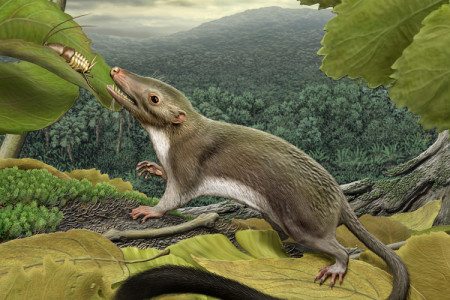
Detailed artistic reconstruction of an ancestral placental mammal living during the Age of Dinosaurs 66 million years ago, showing teeth adapted to capturing and eating insects. (Courtesy of Carl Buell)
A genome study of 107 different species of mammals showed that people's distant ancestors, the small, furry creatures that scurried around the feet of the dinosaurs 66 million years ago, were mostly insect eaters.
Scientists from University of California, Berkeley reported on Wednesday in the journal Science Advances that genes for some enzymes that allowed these early ancestors of all mammals to digest insects were still hanging around in nearly all mammal genomes today.
Even animals like tigers and seals that would never touch an insect have non-functional pieces of these genes sitting in their chromosomes, betraying their ancient ancestors' diet, according to the study.
Previous study had shown that humans and mice had a gene for chitinase, an enzyme that broke down insects' hard and chitin-containing outer shells, but humans also had remnants of three other chitinase genes in their genome, though none of them functional.
Emerling's team showed that these gene remnants in humans were not unique to humans or primates, but instead can be traced to the ancestral placental mammals.
They found five different chitinase enzyme genes by looking through the genomes of the largest group of mammals, those that have placentas. These placental mammals ranged from shrews and mice to elephants and whales.
They found that the greater the percentage of insects in an animal's diet, the more genes for chitinase it has.
"The only species that have five chitinases today are highly insectivorous, that is, 80 to 100 percent of their diet consists of insects. Since the earliest placental mammals likely had five chitinases, we think that this makes for a strong argument that they were highly insectivorous," said the university's postdoctoral fellow Christopher Emerling.
According to the researchers, the story told by these chitinase genes is one of early mammals hunkering down eating insects while the big guys, the huge herbivorous dinosaurs like the brontosaurus and the big meat-eaters like T. rex gobbled up the most abundant food resources.
Only 66 million years ago at the end of the Cretaceous Period, when all non-bird dinosaurs died out, were mammals able to expand into other ecological niches, which they quickly did.
The first carnivorous and herbivorous mammals, as indicated by their teeth, arose within 10 million years of the dinosaurs' demise.
Emerling's team suggested that chitinases could answer about mammal evolution and physiology.
"This is suggesting that there are a lot of these enzymes that might be helping organisms digest their food," said Emerling.
The genetic evidence independently corroborates the conclusions paleontologists reached years ago based on the shapes of fossils and teeth from early mammals.
"In essence, we are looking at genomes and they are telling the same story as the fossils: that we think these animals were insectivorous and then dinosaurs went extinct. After the demise of these large carnivorous and herbivorous reptiles, mammals started changing their diets," said Emerling.
Also, the finding could shed light on other roles played by these enzymes which are found not only in the gut but the salivary glands, the pancreas and the lungs, where they may be involved in asthma.


















































